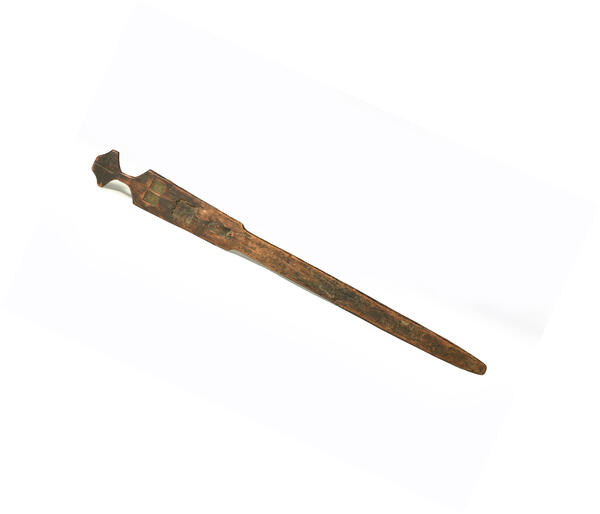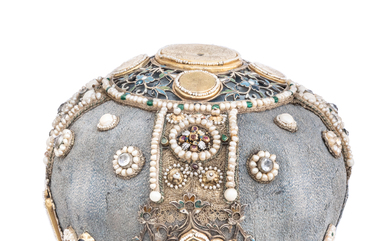A portable iconostasis was necessary for praying to God when there was no church, for example during a journey or away from home. Thus one could avoid carrying numerous icons, which took up space and increased the weight of the luggage. Moreover, the iconostasis provided believers with all the necessary icons. In military regiments, such items were usually called folding icons and consisted of several metal plates, which could be easily folded or unfolded if necessary.
The portable iconostases of Siberian priests looked different. The Tobolsk Historical and Architectural Museum-Reserve houses one such exhibit. It looks like an oblong dagger, with a carved pommel and rounded point, which was probably used to hold the object upright during worship services. The item was carved from a single piece of wood and painted reddish brown.
The pommel is diamond-shaped, with a carved four-pointed cross. It is connected to the middle part by a thin link. The central part is made as a rectangular blade slightly flaring upwards. Four recesses are arranged in three rows. Miniature copper icons of Jesus Christ and Nicholas the Wonderworker have survived in the two upper rows. The edges are decorated with floral patterns. The other three recesses have an irregular shape, and the icons in them have been lost.
In Siberia, Orthodox priests had to travel time and again through the eparchy. They went to indigenous peoples and preached to convert them to the Christian faith. In addition, the clergymen studied local languages, treated the sick, encouraged commerce, and educated the nomads.
It was often difficult to find an Orthodox church nearby during these trips. The indigenous peoples had no churches and there could be many kilometers from towns and villages. Therefore, worships were often performed on the way. Sometimes people had to pray in the open air, though more often the priests set up a special camp church, a light structure made of available materials.
The portable iconostases of Siberian priests looked different. The Tobolsk Historical and Architectural Museum-Reserve houses one such exhibit. It looks like an oblong dagger, with a carved pommel and rounded point, which was probably used to hold the object upright during worship services. The item was carved from a single piece of wood and painted reddish brown.
The pommel is diamond-shaped, with a carved four-pointed cross. It is connected to the middle part by a thin link. The central part is made as a rectangular blade slightly flaring upwards. Four recesses are arranged in three rows. Miniature copper icons of Jesus Christ and Nicholas the Wonderworker have survived in the two upper rows. The edges are decorated with floral patterns. The other three recesses have an irregular shape, and the icons in them have been lost.
In Siberia, Orthodox priests had to travel time and again through the eparchy. They went to indigenous peoples and preached to convert them to the Christian faith. In addition, the clergymen studied local languages, treated the sick, encouraged commerce, and educated the nomads.
It was often difficult to find an Orthodox church nearby during these trips. The indigenous peoples had no churches and there could be many kilometers from towns and villages. Therefore, worships were often performed on the way. Sometimes people had to pray in the open air, though more often the priests set up a special camp church, a light structure made of available materials.



